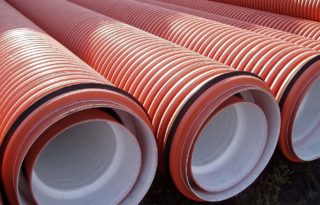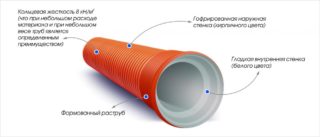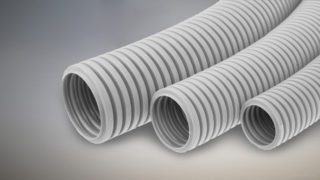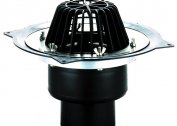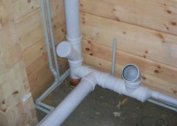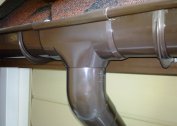To reduce labor costs and the cost of sewage, builders increasingly prefer corrugated pipes from various polymeric materials. In terms of strength and service life, they practically do not differ from steel or cast iron, have a lower cost, they are easier to fit together.
Scope of corrugated sewer pipes
Corrugated flexible pipes for plastic sewage are used in the same cases as ordinary ones, but the degree of reliability is higher. To equip a suburban autonomous sewer, stormwater, to conduct water supply to the house - all this can be done using corrugated pipes.
The corrugated surface is especially relevant where there is a danger of damage to the highway due to the geological features of the terrain - in the mountains, on the banks of the river, in seismically active zones. Soil movements - landslides, earthquakes - can destroy the entire water supply or sewage system in a matter of minutes. Linear stretching is reduced to zero if the soil falls between the convex parts and holds the line in position.
Ring stiffness is needed if the pressure in the system is unstable. Water hammer often leads to rupture of the pipe. Convex ribs on the entire surface of the product restrain water pressure and prevent tearing.
Types of corrugated pipes
Corrugated plastic products are used for internal and external sewerage. If the internal wiring can be carried out using less durable pipes, then for external work there are more varieties:
- lungs;
- heavy;
- super heavy constructions.
Light corrugated products by their properties are suitable for outdoor sewage or water supply in a stable soil. Their density is less, the walls are most often single-layer. They are also used for laying electrical cables. They are flexible and flexible, but reliably protect the cable hidden inside from damage during earthwork. Since light corrugated pipes are afraid of ultraviolet radiation, they are not recommended for use outside the building or on the surface of the ground. Distinguished by degree of rigidity:
- SN 2 marking is intended for laying to a depth of not more than 2 meters - these are single-layer products;
- SN 4 - up to 3 meters;
- two-layer SN 6 - up to 4 meters;
- two-layer SN 8 and SN 16 - up to 10 meters.
Heavy corrugated pipes are used in moving soil for laying to great depths. If the depth is less than recommended by technical specifications, the pipes will last longer due to reduced load. They are used for urban communications, which are located near pedestrian roads or highways. So that the products are not clogged with soil and stones, they are released in a protective sheath of geotextiles.
Superheavy pipes are made of two layers and are intended for laying in the ground under railway rails or roads with heavy traffic, where the level of pressure on the ground and vibrations are increased. This kind is made without a protective shell.
According to the functional purpose
Corrugated pipes are used for various purposes, one of which is to hide electrical communications or light hoses to avoid damage. The density of the material is less, so the products are more flexible and elastic. These qualities also depend on the material of the pipe. If necessary, you can repair the house, remove the plaster and get the corrugated single-layer hose, replacing it with a new one.
Heavy and super heavy constructions are not designed for frequent replacement - they are laid deep and for a long time, so the degree of strength must exceed the adverse environmental conditions. In this case, the service life of massive structures will be more than 50 years.
A smooth inner surface allows for quick passage of effluents along the highway. Organic particles do not have time to cling to the walls, so they will not need to be cleaned soon. According to reviews on construction forums, some owners for the first time washed pipes with chemicals after 10 years of operation.
In heating systems, pipes give the room an aesthetic appearance, as they are painted white.
According to the properties and material of manufacture
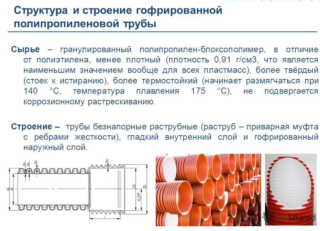 Based on the material used in the manufacture of corrugated pipes, we can conclude about their properties:
Based on the material used in the manufacture of corrugated pipes, we can conclude about their properties:
- density;
- thermal conductivity;
- resistance to chemicals;
- UV exposure;
- impact resistance;
- resistance to fire;
- linear and circular stretching;
- resistance to low temperatures.
PolypropyleneIt is able to withstand temperatures from - 20 to + 95 degrees, so it is used to drain hot liquids in industries.
The material is resistant to chemicals - acids, alkalis, alcohols. The presence of aggressive substances does not change the structure of the inner surface of the walls. Lime and iron ions cannot stick to a smooth surface due to the high flow velocity. In household sewers, the same thing happens with organic matter - it does not accumulate on the walls.
For different purposes, polypropylene reinforced with fiberglass or aluminum foil is used. This increases strength and durability.
Connect pipes made of plastic using fittings or welding. In the first case, angular adapters or couplings are used, in the second, pipes are fastened with a soldering iron in a straight section.
PVC - The most commonly used material in everyday life. It is preferable to use in non-pressure systems, as the material withstands pressure up to 0.16 MPa in strength. Polyvinyl chloride is 5 times lighter than metal, so installation is much easier - you can not even use heavy equipment.
Since the inner surface is smooth, organic matter in an autonomous home sewage system does not grow on the walls and does not contribute to the multiplication of microorganisms. Therefore, there is no smell in the house and on the site.
PVC is used to equip the water supply, since the material is non-toxic and does not support the growth of bacteria. It is safe in internal wiring - it does not ignite, it does not deform when heated. The only drawback is that it does not tolerate low temperatures. At 10 degrees below zero, it becomes brittle, therefore, before laying in the ground, the pipes are wrapped with heat-insulating material.
For home sewage and summer plumbing, you can use polyethylene. Its elasticity has been proven empirically: when freezing water in polyethylene pipes, they did not burst, but only slightly stretched. The lower temperature limit is 0 degrees.
In ordinary pipes, the temperature of the transported liquid should not exceed 45 degrees, based on the manufacturer's recommendations. But after the experiments, we can say that the products withstand short-term heating up to 80 degrees and are not destroyed.
Different grades of material are designed for different soil pressure. Based on the planned depth of the bookmark, choose the appropriate option for density, diameter, strength. The number of layers and material modification matters:
- LDPE - high pressure polyethylene;
- HDPE - low pressure polyethylene;
- crosslinked polyethylene.
The pipes are marked in the form of a colored tape that indicates what the product is intended for.
Dimensions
Corrugated pipes have two diameters - inner and outer.The difference is from 19 to 170 mm, depending on the size of the protruding stiffeners.
The pipe with an inner diameter of 4 to 11 cm is considered the most popular corrugation size for internal work. For outdoor work, larger diameter products with a wider wall thickness and heavy weight are used.
For urban communications use corrugated pipes with an internal diameter of up to 103 cm, an external one - 120 cm and a wall thickness of 0.5 cm.
Mounting Features
All work with plastic products is preferably performed in the warm season, when the temperature in the street is above 15 degrees. Corrugated pipes are laid in the ground on a prepared foundation of sand or reinforced concrete. When connecting with a socket, it should be directed in the direction opposite to the slope, to prevent leakage of liquid.
In the welded method, the wall thickness and type of welding machine are taken into account. The polymer is heated until it begins to melt, then combined with the other part and held until the plastic dries. With proper welding, a monolithic seam is obtained.
When connecting through a bell inside the walls there will be no scoring and unevenness, for which large particles will cling. It is advisable to install a viewing well at the welding site, so that in the event of a blockage, you can cut the pipe and clean it.
Corrugation can be combined with other materials - steel or cast iron. In this case, couplings with fasteners are used.
Advantages and disadvantages
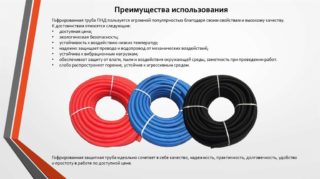 The disadvantages of plastic corrugated pipes include low resistance to high temperatures, but there are exceptions: PVC is more vulnerable to low temperatures, so you need to clearly understand what purpose pipes are selected for.
The disadvantages of plastic corrugated pipes include low resistance to high temperatures, but there are exceptions: PVC is more vulnerable to low temperatures, so you need to clearly understand what purpose pipes are selected for.
If you need to hide the electric cable, PVC is suitable for this purpose, because high-pressure polyethylene enhances combustion and, if it is shorted in the wiring, can cause a fire.
It is not recommended to use plastic for mounting a surface water supply or sewage system, since most materials are not resistant to ultraviolet radiation.
Some types of plastic let moisture through because of the low density of the material, so when buying, you need to specify what will be transported through the pipes.
When arranging the internal wiring in apartment panel houses, additional sound insulation is required, since plastic well passes sound from liquids and drains passing through them.
Common benefits for all plastic corrugated pipes:
- have a high degree of strength;
- serve with proper operation for more than 50 years, the maximum period declared by the manufacturer is 90 years;
- good shockproof properties;
- non-toxic, do not emit hazardous substances in water;
- easy to install thanks to special devices - sockets;
- light weight in relation to metal and cast iron.
Almost all plastic is neutral to the action of aggressive chemicals - acids and alkalis.
The cost of corrugated products is an order of magnitude higher than conventional plastic pipes. Depends on the length, diameter, wall thickness, as well as the material of manufacture. Prices for double-layer corrugated pipes for external sewage are higher than for single-layer. Reinforced brands will also cost more, since their service life and strength are higher. The most affordable prices are the products of domestic plants for the production of sewer pipes and parts for them.
